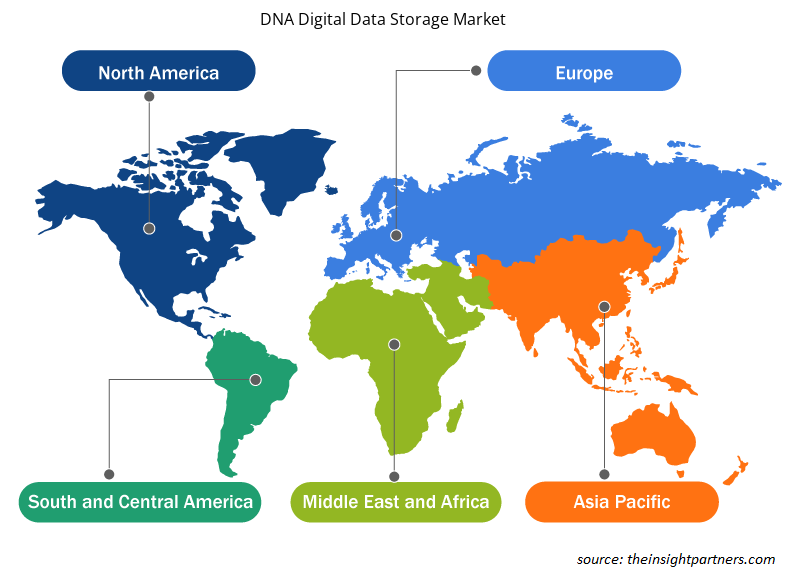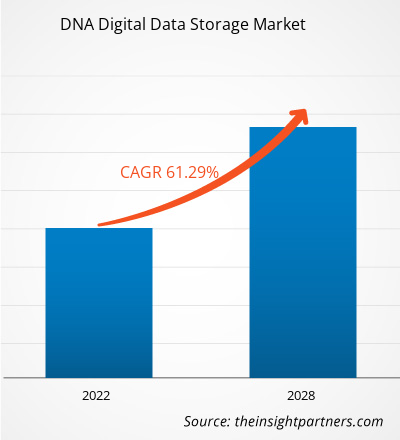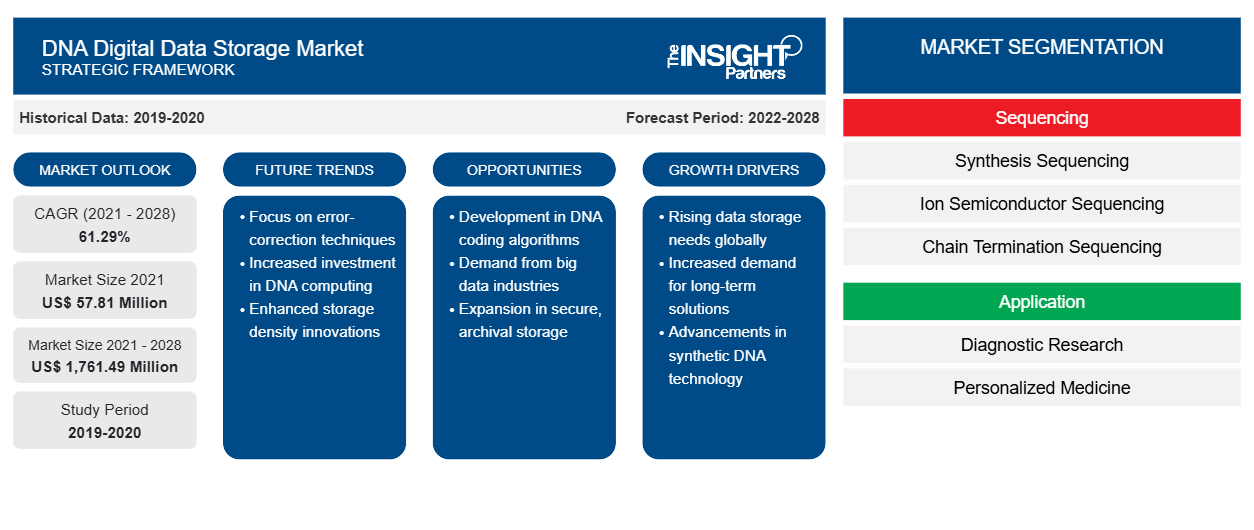DNA 数字数据存储市场预计将从 2021 年的 5781 万美元增长到 2028 年的 17.6149 亿美元;预计 2021 年至 2028 年期间的复合年增长率为 61.29%。CAGR of 61.29% during 2021 to 2028.
DNA 数字数据存储是一种将二进制数据编码为合成的 DNA 链并从合成的 DNA 链解码的方法。DNA 因其高存储密度和耐用性而成为数字信息存储介质,这优于现有的硅基存储介质,因此引起了人们的兴趣。此外,DNA 的四字母核苷酸代码提供了合适的编码环境,可以像计算机和其他电子设备使用二进制数字代码来表示任何字母、数字或其他字符一样使用。
定制此报告以满足您的需求
您可以免费定制任何报告,包括本报告的部分内容、国家级分析、Excel 数据包,以及为初创企业和大学提供优惠和折扣
- 获取此报告的关键市场趋势。这个免费样品将包括数据分析,从市场趋势到估计和预测。
推动全球 DNA 数字数据存储市场增长的因素包括 DNA 数字数据存储服务提供商的存在以及与 DNA 数据存储相关的积极投资和业务创新,这些都是推动市场增长的因素。然而,替代品的可用性和相关限制阻碍了市场的增长。尽管存在这些限制,但 DNA 数据存储的应用日益增多,将在预测期内为 DNA 数字数据存储市场的参与者创造巨大的机会。
市场洞察
DNA 数据存储的应用日益广泛
DNA 数据存储在医疗保健和相关服务提供商中越来越受欢迎。法医、个性化医疗、诊断等是 DNA 数据存储的一些应用领域。与传统存储模式相比,DNA 存储可提供长期数据存储。对较小数据空间存储大量数据的需求不断增长,预计将为市场参与者创造机会。制药公司、研究机构和安全机构使用和探索 DNA 数据存储,以便在较小的空间中存储最大数据。
由于 DNA 存储技术处于开发初期,尚未大规模商业化,因此产品创新和开发潜力巨大。各种公司和研究机构都积极参与 DNA 存储开发活动。例如,2021 年 8 月,华盛顿大学和微软的研究人员开发了 NANOPORE-TAL,它将使细胞能够与计算机通信。此外,2021 年,微软与华盛顿大学分子信息实验室合作开发了一种新芯片,以展示将 DNA 合成点紧密包装三个数量级的能力,并展示更高的 DNA 写入吞吐量。因此,DNA 数据存储的不断增长的应用预计将在未来为 DNA 数字数据存储市场参与者和其他最终用户创造丰厚的机会。
基于测序的见解
DNA 数字数据存储市场按测序方式细分为合成测序、离子半导体测序、链终止测序、连接测序、纳米孔测序。2021 年,合成测序领域可能占据最大的市场份额。然而,预计未来几年纳米孔测序领域将以最快的速度增长。
基于应用的洞察
DNA 数字数据存储市场根据应用细分为诊断研究、个性化医疗等。诊断研究领域很可能在 2021 年占据最大的市场份额,预计在预测期内将实现最高的复合年增长率。
DNA 数字数据存储市场区域洞察
Insight Partners 的分析师已详尽解释了预测期内影响 DNA 数字数据存储市场的区域趋势和因素。本节还讨论了北美、欧洲、亚太地区、中东和非洲以及南美和中美洲的 DNA 数字数据存储市场细分和地理位置。

- 获取 DNA 数字数据存储市场的区域特定数据
DNA 数字数据存储市场报告范围
| 报告属性 | 细节 |
|---|---|
| 2021 年市场规模 | 5,781万美元 |
| 2028 年市场规模 | 17.6149亿美元 |
| 全球复合年增长率(2021 - 2028) | 61.29% |
| 史料 | 2019-2020 |
| 预测期 | 2022-2028 |
| 涵盖的领域 | 按排序
|
| 覆盖地区和国家 | 北美
|
| 市场领导者和主要公司简介 |
|
DNA 数字数据存储市场参与者密度:了解其对业务动态的影响
DNA 数字数据存储市场正在快速增长,这得益于终端用户需求的不断增长,而这些需求又源于消费者偏好的不断变化、技术进步以及对产品优势的认识不断提高等因素。随着需求的增加,企业正在扩大其产品范围,进行创新以满足消费者的需求,并利用新兴趋势,从而进一步推动市场增长。
市场参与者密度是指在特定市场或行业内运营的企业或公司的分布情况。它表明在给定市场空间中,相对于其规模或总市场价值,有多少竞争对手(市场参与者)存在。
在 DNA 数字数据存储市场运营的主要公司有:
- Illumina公司
- Twist 生物科学
- 安捷伦科技公司
- 分子组装
- 量子公司
免责声明:上面列出的公司没有按照任何特定顺序排列。

- 获取 DNA 数字数据存储市场顶级关键参与者概览
基于最终用户的洞察
根据最终用户,DNA 数字数据存储市场分为学术和研究机构、制药和生物技术公司、医院和诊所等。学术和研究机构部分很可能在 2021 年占据最大的市场份额,预计在预测期内将实现最高的复合年增长率
产品发布和审批是公司扩大全球影响力和产品组合的常用策略。此外,基因组编辑市场参与者专注于合作策略来扩大客户群,这反过来又使他们能够在全球范围内保持自己的品牌知名度。
公司简介
- Illumina公司
- Twist 生物科学
- 安捷伦科技公司
- 分子组装
- 量子公司
- 目录
- 微软公司
- 铱瑞公司
- F.霍夫曼-拉罗氏有限公司
- DNA脚本
- Evonetix。
- 历史分析(2 年)、基准年、预测(7 年)及复合年增长率
- PEST和SWOT分析
- 市场规模、价值/数量 - 全球、区域、国家
- 行业和竞争格局
- Excel 数据集
近期报告
相关报告
客户评价
购买理由
- 明智的决策
- 了解市场动态
- 竞争分析
- 客户洞察
- 市场预测
- 风险规避
- 战略规划
- 投资论证
- 识别新兴市场
- 优化营销策略
- 提升运营效率
- 顺应监管趋势





















 获取免费样品 - DNA数字数据存储市场
获取免费样品 - DNA数字数据存储市场